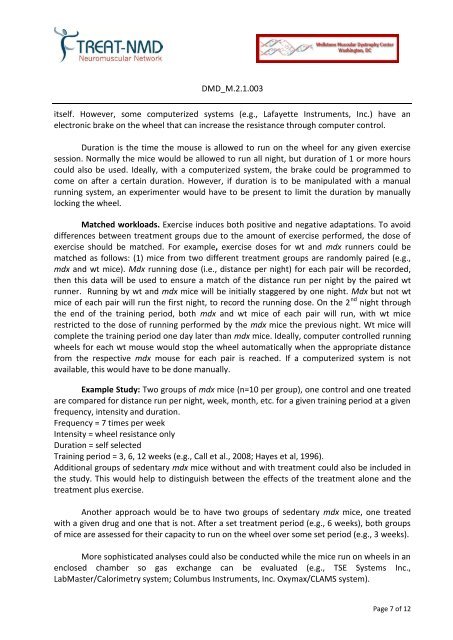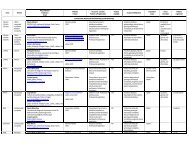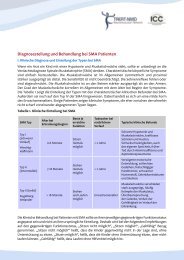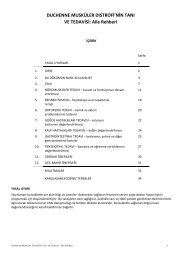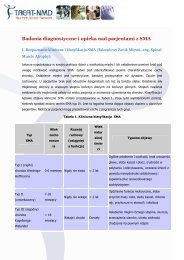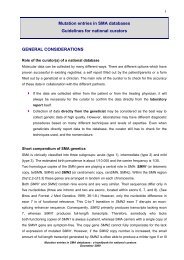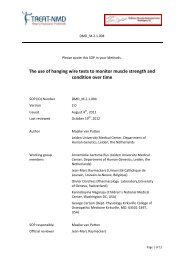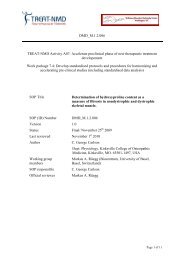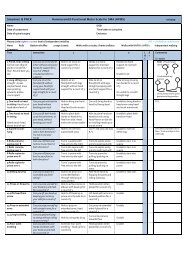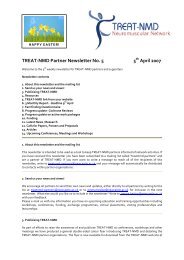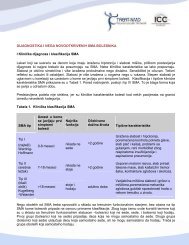Use of treadmill and wheel exercise to assess ... - Treat-NMD
Use of treadmill and wheel exercise to assess ... - Treat-NMD
Use of treadmill and wheel exercise to assess ... - Treat-NMD
Create successful ePaper yourself
Turn your PDF publications into a flip-book with our unique Google optimized e-Paper software.
DMD_M.2.1.003<br />
itself. However, some computerized systems (e.g., Lafayette Instruments, Inc.) have an<br />
electronic brake on the <strong>wheel</strong> that can increase the resistance through computer control.<br />
Duration is the time the mouse is allowed <strong>to</strong> run on the <strong>wheel</strong> for any given <strong>exercise</strong><br />
session. Normally the mice would be allowed <strong>to</strong> run all night, but duration <strong>of</strong> 1 or more hours<br />
could also be used. Ideally, with a computerized system, the brake could be programmed <strong>to</strong><br />
come on after a certain duration. However, if duration is <strong>to</strong> be manipulated with a manual<br />
running system, an experimenter would have <strong>to</strong> be present <strong>to</strong> limit the duration by manually<br />
locking the <strong>wheel</strong>.<br />
Matched workloads. Exercise induces both positive <strong>and</strong> negative adaptations. To avoid<br />
differences between treatment groups due <strong>to</strong> the amount <strong>of</strong> <strong>exercise</strong> performed, the dose <strong>of</strong><br />
<strong>exercise</strong> should be matched. For example, <strong>exercise</strong> doses for wt <strong>and</strong> mdx runners could be<br />
matched as follows: (1) mice from two different treatment groups are r<strong>and</strong>omly paired (e.g.,<br />
mdx <strong>and</strong> wt mice). Mdx running dose (i.e., distance per night) for each pair will be recorded,<br />
then this data will be used <strong>to</strong> ensure a match <strong>of</strong> the distance run per night by the paired wt<br />
runner. Running by wt <strong>and</strong> mdx mice will be initially staggered by one night. Mdx but not wt<br />
mice <strong>of</strong> each pair will run the first night, <strong>to</strong> record the running dose. On the 2 nd night through<br />
the end <strong>of</strong> the training period, both mdx <strong>and</strong> wt mice <strong>of</strong> each pair will run, with wt mice<br />
restricted <strong>to</strong> the dose <strong>of</strong> running performed by the mdx mice the previous night. Wt mice will<br />
complete the training period one day later than mdx mice. Ideally, computer controlled running<br />
<strong>wheel</strong>s for each wt mouse would s<strong>to</strong>p the <strong>wheel</strong> au<strong>to</strong>matically when the appropriate distance<br />
from the respective mdx mouse for each pair is reached. If a computerized system is not<br />
available, this would have <strong>to</strong> be done manually.<br />
Example Study: Two groups <strong>of</strong> mdx mice (n=10 per group), one control <strong>and</strong> one treated<br />
are compared for distance run per night, week, month, etc. for a given training period at a given<br />
frequency, intensity <strong>and</strong> duration.<br />
Frequency = 7 times per week<br />
Intensity = <strong>wheel</strong> resistance only<br />
Duration = self selected<br />
Training period = 3, 6, 12 weeks (e.g., Call et al., 2008; Hayes et al, 1996).<br />
Additional groups <strong>of</strong> sedentary mdx mice without <strong>and</strong> with treatment could also be included in<br />
the study. This would help <strong>to</strong> distinguish between the effects <strong>of</strong> the treatment alone <strong>and</strong> the<br />
treatment plus <strong>exercise</strong>.<br />
Another approach would be <strong>to</strong> have two groups <strong>of</strong> sedentary mdx mice, one treated<br />
with a given drug <strong>and</strong> one that is not. After a set treatment period (e.g., 6 weeks), both groups<br />
<strong>of</strong> mice are <strong>assess</strong>ed for their capacity <strong>to</strong> run on the <strong>wheel</strong> over some set period (e.g., 3 weeks).<br />
More sophisticated analyses could also be conducted while the mice run on <strong>wheel</strong>s in an<br />
enclosed chamber so gas exchange can be evaluated (e.g., TSE Systems Inc.,<br />
LabMaster/Calorimetry system; Columbus Instruments, Inc. Oxymax/CLAMS system).<br />
Page 7 <strong>of</strong> 12


